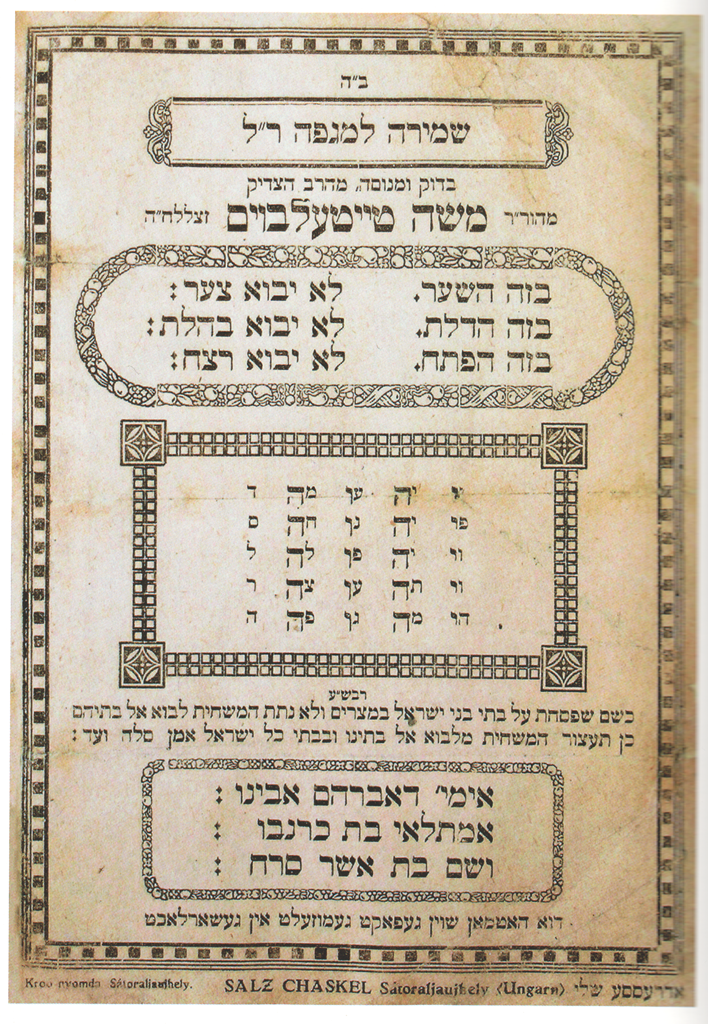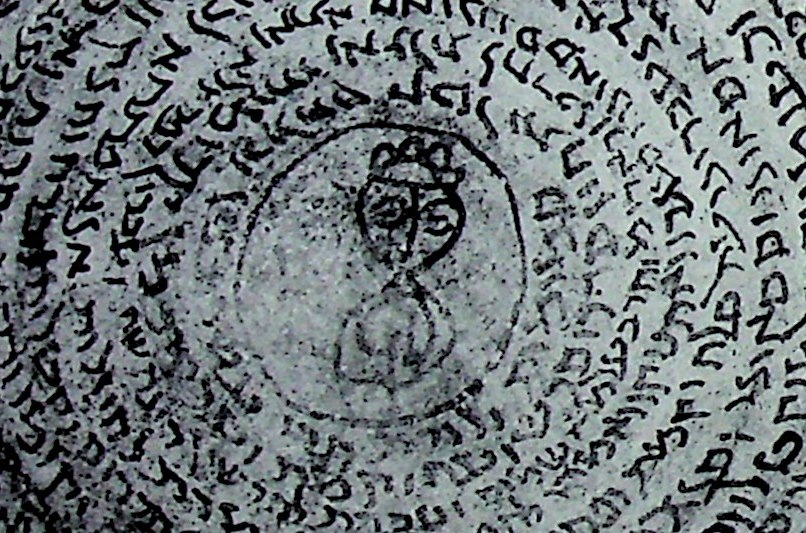| Source (Hebrew) | Translation (English) |
|---|---|
בזה השער, לא יבוא צער׃ בזה הדלת, לא יבוא בהלת׃ בזה הפתח, לא יבוא רצח׃ |
Through this gate, let no sadness enter: Through this door, let no fear enter Through this portal/opening, let no murder enter. |
וַיַּעֲמֹ֣ד פִּֽ֭ינְחָס וַיְפַלֵּ֑ל וַ֝תֵּעָצַ֗ר הַמַּגֵּפָֽה׃ |
And Pinḥas stepped forth and intervened, and the plague ceased.[1] The Tetragrammaton is interwoven between each of the five letters of the five words in the verse, Psalms 106:30. |
רבש״ע כשם שפסחת על בתי בני ישראל במצרים ולא נתת המשחית לבוא אל בתיהם כן תעצור המשחית מלבוא אל בתינו ובבתי כל ישראל אמן סלה ועד׃ |
Master of the Cosmos, Just as it passed over the houses of the children of Yisrael in Mitsrayim, rather than letting the Mashḥit (Executioner) enter their homes, so the Mashḥit will stop coming into our homes and the residences of all of Yisrael. Amen Selah Forever. |
אימי׳ דאברהם אבינו׃ אמתלאי בת כרנבו׃ ושם בת אשר סרח׃ |
[In the merit of the] Mother of our father Avraham: Amiltai[2] The text here reads “Amatlai” as found in Bava Batra 91a, but this is a corruption of Amiltai (or Amalthea) of Karnavu. From an article by Kaufmann Kohler in the Jewish Encyclopedia (1906): “In Greek mythology, the goat, whose horn overflowing with nature’s riches has become the symbol of plenty (the cornucopia), and that nursed the infant god Zeus with her milk. This name occurs twice in ancient Jewish legend: (1) Job’s daughter, Kerenhappuch (Job, xlii. 14), is translated in the Septuagint “Amalthea’s Horn,” wherein the Hebrew words קרן הפוך are reproduced. This daughter of Job, Amalthea’s Horn, plays a prominent role as a type of saintly beauty in the “Testament of Job”—a Jewish apocrypha (see Kohler, “Testament of Job” in “Semitic Studies in Memory of Al. Kohut,” p. 288); her “unicorn-like beauty” and her “smaragd-like radiance” are dwelt on also in Bava Batra 16b. (2) The name of Abraham’s mother, called Edna (the Graceful One) in the Book of Jubilees (11:13), is said by Rab (Bava Batra 91a) to have been Amatlai, the daughter of Karnebo, which seems to be a corrupt reproduction of Amalthea-Keren-happuch, the daughter of Job—Job’s and Abraham’s histories being constantly interwoven in ancient legend. Possibly the Zeus legend prompted the name, as it is narrated that the infant Abraham was miraculously nourished by milk and honey in the cave where he was hidden.” For more on this segulah, find this post. bat Karnavu[3] As noted by Henry George Tomkins, “There was a town called by the name Kar-Nebo (Kar-Nabu, wall of Nebo) in Assyria, mentioned on the Paris Michaux Stone. (Records of the Past, Vol. IX., p. 94 ; Del. Wo lag das Par. 1 206). This was not far from Bagdad. Does not “daughter of Karnebo” mean a native of this town? or should we now refer it rather to Karnavu, an Arabian city mentioned by Hommel from one of Glaser’s Minæan inscriptions. (Hommel, Am. Heb. Trad. 250, 274.)” in Abraham and his Age (1897). And the name of the daughter of Asher was Seraḥ.[4] I am not certain but I think that name of Seraḥ here may be invoked due to her famous long-livedness in midrash aggadah. |
דוא האטמאן שױן געפאקט געמוזעלט אין געשארלאכט |
These leaflet amulets were mass-printed in the 19th and early 20th century. The kame’a (amulet) itself is attributed to Rabbi Moshe Teitelbaum (1759-1841). We are not certain which epidemic it was composed in response to although cholera and measles epidemics were endemic throughout the 19th century. Derivations of the formula here developed into the Birkat haBayit found suspended near doorways of many Jewish homes.
We are indebted to Jacobus Swart for his explanation of this ḳame’a as found in his The Book of Seals & Amulets (Sangreal Sodality Press 2014). Thank you!
Source

Amulet for Protection Against Plagues, attributed to Rabbi Moshe Teitelbaum (1759-1841) Hungary, 1925
Notes
| 1 | The Tetragrammaton is interwoven between each of the five letters of the five words in the verse, Psalms 106:30. |
|---|---|
| 2 | The text here reads “Amatlai” as found in Bava Batra 91a, but this is a corruption of Amiltai (or Amalthea) of Karnavu. From an article by Kaufmann Kohler in the Jewish Encyclopedia (1906): “In Greek mythology, the goat, whose horn overflowing with nature’s riches has become the symbol of plenty (the cornucopia), and that nursed the infant god Zeus with her milk. This name occurs twice in ancient Jewish legend: (1) Job’s daughter, Kerenhappuch (Job, xlii. 14), is translated in the Septuagint “Amalthea’s Horn,” wherein the Hebrew words קרן הפוך are reproduced. This daughter of Job, Amalthea’s Horn, plays a prominent role as a type of saintly beauty in the “Testament of Job”—a Jewish apocrypha (see Kohler, “Testament of Job” in “Semitic Studies in Memory of Al. Kohut,” p. 288); her “unicorn-like beauty” and her “smaragd-like radiance” are dwelt on also in Bava Batra 16b. (2) The name of Abraham’s mother, called Edna (the Graceful One) in the Book of Jubilees (11:13), is said by Rab (Bava Batra 91a) to have been Amatlai, the daughter of Karnebo, which seems to be a corrupt reproduction of Amalthea-Keren-happuch, the daughter of Job—Job’s and Abraham’s histories being constantly interwoven in ancient legend. Possibly the Zeus legend prompted the name, as it is narrated that the infant Abraham was miraculously nourished by milk and honey in the cave where he was hidden.” For more on this segulah, find this post. |
| 3 | As noted by Henry George Tomkins, “There was a town called by the name Kar-Nebo (Kar-Nabu, wall of Nebo) in Assyria, mentioned on the Paris Michaux Stone. (Records of the Past, Vol. IX., p. 94 ; Del. Wo lag das Par. 1 206). This was not far from Bagdad. Does not “daughter of Karnebo” mean a native of this town? or should we now refer it rather to Karnavu, an Arabian city mentioned by Hommel from one of Glaser’s Minæan inscriptions. (Hommel, Am. Heb. Trad. 250, 274.)” in Abraham and his Age (1897). |
| 4 | I am not certain but I think that name of Seraḥ here may be invoked due to her famous long-livedness in midrash aggadah. |

“קמע לשמירת המגפה | Amulet for Protection from the Plague, attributed to Rabbi Moshe Teitelbaum (ca. 19th c.)” is shared through the Open Siddur Project with a Creative Commons Attribution-ShareAlike 4.0 International copyleft license.

![[Ḳameʻ] : [ʻavur Mirḳada d.m Ṿiadah bat Donah] (Columbia University Hebrew Manuscripts Collection, MS General 194) - cropped](https://opensiddur.org/wp-content/uploads/2020/08/ldpd_11683790_000_00000001-featured-image.jpg)








what’s the translation of the yiddish line at the end?
I’d like to know too
Here we have already been through smallpox, measles and scarlet fever [therefore go someplace else].
(Here we pocked, measled and scarletted) [Been there, done that]